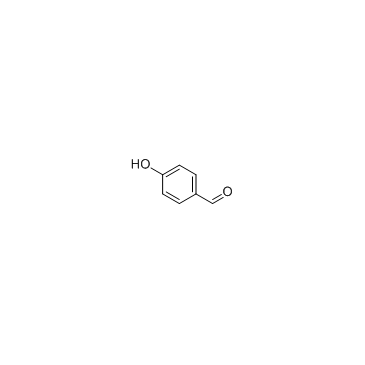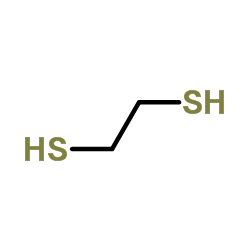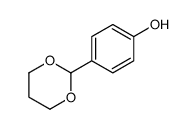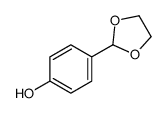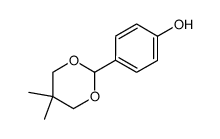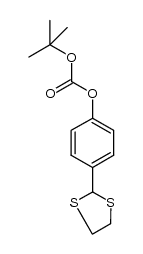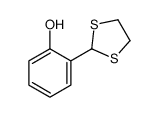22068-49-1
| Name | 4-(1,3-dithiolan-2-yl)phenol |
|---|---|
| Synonyms |
Phenol,p-(1,3-dithiolan-2-yl)
1,3-Dithiolane,2-(4-hydroxyphenyl) 4-[1,3]dithiolan-2-yl-phenol MFCD00068127 4-hydroxyphenyl-1,3-dithiolane p-(1,3-Dithiolan-2-yl)phenol 2-(4-hydroxyphenyl)-1,3-dithiolane |
| Density | 1.319g/cm3 |
|---|---|
| Boiling Point | 376.4ºC at 760mmHg |
| Melting Point | 114 °C |
| Molecular Formula | C9H10OS2 |
| Molecular Weight | 198.30500 |
| Flash Point | 183ºC |
| Exact Mass | 198.01700 |
| PSA | 70.83000 |
| LogP | 2.87080 |
| Vapour Pressure | 3.35E-06mmHg at 25°C |
| Index of Refraction | 1.675 |
Synonym: Section 2 - COMPOSITION, INFORMATION ON INGREDIENTS
Risk Phrases: 20/21/22 36/37/38 Section 3 - HAZARDS IDENTIFICATION EMERGENCY OVERVIEW
Harmful by inhalation, in contact with skin and if swallowed. Irritating to eyes, respiratory system and skin. Potential Health Effects Eye: Causes eye irritation. Skin: Causes skin irritation. Harmful if absorbed through the skin. Ingestion: Harmful if swallowed. May cause irritation of the digestive tract. Inhalation: Harmful if inhaled. Causes respiratory tract irritation. Chronic: Not available. Section 4 - FIRST AID MEASURES Eyes: Flush eyes with plenty of water for at least 15 minutes, occasionally lifting the upper and lower eyelids. Get medical aid. Skin: Get medical aid. Flush skin with plenty of water for at least 15 minutes while removing contaminated clothing and shoes. Ingestion: Get medical aid. Wash mouth out with water. Inhalation: Remove from exposure and move to fresh air immediately. If not breathing, give artificial respiration. If breathing is difficult, give oxygen. Get medical aid. Notes to Physician: Section 5 - FIRE FIGHTING MEASURES General Information: As in any fire, wear a self-contained breathing apparatus in pressure-demand, MSHA/NIOSH (approved or equivalent), and full protective gear. Extinguishing Media: Use water spray, dry chemical, carbon dioxide, or chemical foam. Section 6 - ACCIDENTAL RELEASE MEASURES General Information: Use proper personal protective equipment as indicated in Section 8. Spills/Leaks: Vacuum or sweep up material and place into a suitable disposal container. Section 7 - HANDLING and STORAGE Handling: Avoid breathing dust, vapor, mist, or gas. Avoid contact with skin and eyes. Storage: Store in a cool, dry place. Store in a tightly closed container. Section 8 - EXPOSURE CONTROLS, PERSONAL PROTECTION Engineering Controls: Facilities storing or utilizing this material should be equipped with an eyewash facility and a safety shower. Use adequate ventilation to keep airborne concentrations low. Exposure Limits CAS# 22068-49-1: Personal Protective Equipment Eyes: Not available. Skin: Wear appropriate protective gloves to prevent skin exposure. Clothing: Wear appropriate protective clothing to prevent skin exposure. Respirators: Follow the OSHA respirator regulations found in 29 CFR 1910.134 or European Standard EN 149. Use a NIOSH/MSHA or European Standard EN 149 approved respirator if exposure limits are exceeded or if irritation or other symptoms are experienced. Section 9 - PHYSICAL AND CHEMICAL PROPERTIES Physical State: Solid Color: pale yellow Odor: Not available. pH: Not available. Vapor Pressure: Not available. Viscosity: Not available. Boiling Point: Not available. Freezing/Melting Point: 114 - 116 deg C Autoignition Temperature: Not available. Flash Point: Not available. Explosion Limits, lower: Not available. Explosion Limits, upper: Not available. Decomposition Temperature: Solubility in water: Specific Gravity/Density: Molecular Formula: C9H10OS2 Molecular Weight: 198 Section 10 - STABILITY AND REACTIVITY Chemical Stability: Not available. Conditions to Avoid: Incompatible materials. Incompatibilities with Other Materials: Oxidizing agents, bases, amines. Hazardous Decomposition Products: Carbon monoxide, oxides of sulfur, carbon dioxide. Hazardous Polymerization: Has not been reported Section 11 - TOXICOLOGICAL INFORMATION RTECS#: CAS# 22068-49-1: SL3540500 LD50/LC50: Not available. Carcinogenicity: 4-(1,3-Dithiolan-2-yl)phenol - Not listed by ACGIH, IARC, or NTP. Other: See actual entry in RTECS for complete information. Section 12 - ECOLOGICAL INFORMATION Section 13 - DISPOSAL CONSIDERATIONS Dispose of in a manner consistent with federal, state, and local regulations. Section 14 - TRANSPORT INFORMATION IATA No information available. IMO No information available. RID/ADR No information available. Section 15 - REGULATORY INFORMATION European/International Regulations European Labeling in Accordance with EC Directives Hazard Symbols: XN Risk Phrases: R 20/21/22 Harmful by inhalation, in contact with skin and if swallowed. R 36/37/38 Irritating to eyes, respiratory system and skin. Safety Phrases: S 26 In case of contact with eyes, rinse immediately with plenty of water and seek medical advice. S 36/37/39 Wear suitable protective clothing, gloves and eye/face protection. WGK (Water Danger/Protection) CAS# 22068-49-1: No information available. Canada None of the chemicals in this product are listed on the DSL/NDSL list. CAS# 22068-49-1 is not listed on Canada's Ingredient Disclosure List. US FEDERAL TSCA CAS# 22068-49-1 is not listed on the TSCA inventory. It is for research and development use only. SECTION 16 - ADDITIONAL INFORMATION N/A |
CHEMICAL IDENTIFICATION
HEALTH HAZARD DATAACUTE TOXICITY DATA
|
| Hazard Codes | Xn:Harmful; |
|---|---|
| Risk Phrases | R20/21/22;R36/37/38 |
| Safety Phrases | S26-S36/37/39 |
| HS Code | 2934999090 |
|
~98% 
22068-49-1 |
| Literature: Hajipour, Abdol Reza; Pourmousavi, Seied A.; Ruoho, Arnold E. Synthetic Communications, 2008 , vol. 38, # 15 p. 2548 - 2566 |
|
~85% 
22068-49-1 |
| Literature: Bandgar, Babasaheb P.; Uppalla, Lavkumar S.; Sadavarte, Vaibhav S.; Patil, Suresh V. New Journal of Chemistry, 2002 , vol. 26, # 10 p. 1273 - 1276 |
|
~97% 
22068-49-1 |
| Literature: Naik, Sarala; Gopinath, Rangam; Goswami, Mousumi; Patel, Bhisma K. Organic and Biomolecular Chemistry, 2004 , vol. 2, # 11 p. 1670 - 1677 |
|
~99% 
22068-49-1 |
| Literature: Naik, Sarala; Gopinath, Rangam; Goswami, Mousumi; Patel, Bhisma K. Organic and Biomolecular Chemistry, 2004 , vol. 2, # 11 p. 1670 - 1677 |
|
~91% 
22068-49-1 |
| Literature: Pourmousavi, Seied Ali; Hadavankhani, Majid; Zinati, Zahra E-Journal of Chemistry, 2011 , vol. 8, # SUPPL. 1 p. S495-S501 |
|
~91% 
22068-49-1 |
| Literature: Chankeshwara, Sunay V.; Chebolu, Rajesh; Chakraborti, Asit K. Journal of Organic Chemistry, 2008 , vol. 73, # 21 p. 8615 - 8618 |
|
~% 
22068-49-1
Detail
|
| Literature: Bulletin of the Chemical Society of Japan, , vol. 54, # 7 p. 2120 - 2123 |
| HS Code | 2934999090 |
|---|---|
| Summary | 2934999090. other heterocyclic compounds. VAT:17.0%. Tax rebate rate:13.0%. . MFN tariff:6.5%. General tariff:20.0% |
